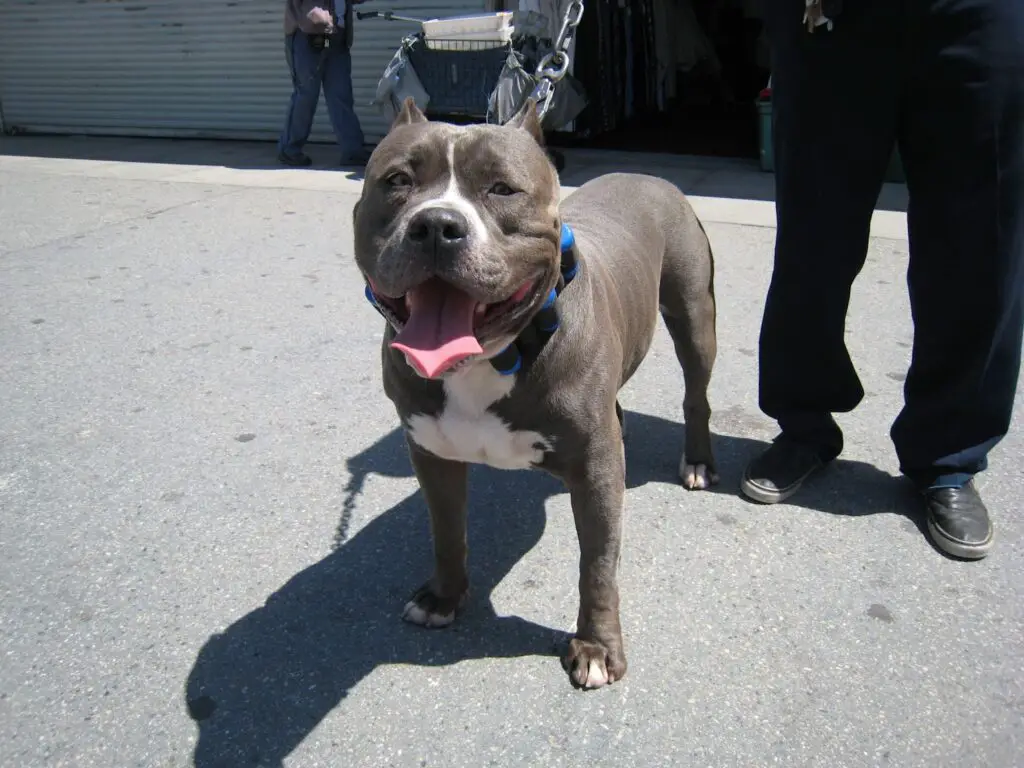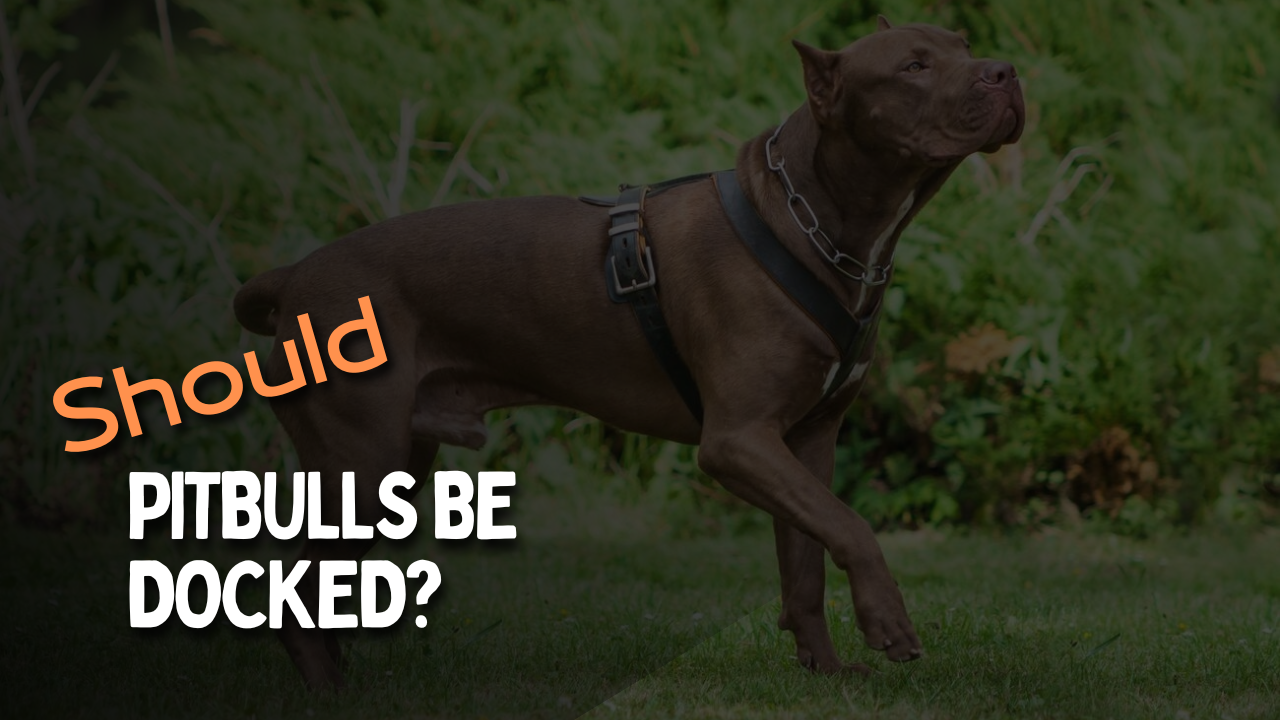Tail docking is an ancient practice and is a decision many new pitbull owners face. Whether pit bulls should be docked is a personal choice for every owner – although some countries and states also have regulations regarding this procedure.
This article discusses the pros and cons of tail docking in pitbulls, providing a comprehensive guide to help you make the best decision for your pup.
Pit Bulls and Tail Docking
Tail docking involves removing part of a pup’s tail. The procedure is either requested by breeders or new owners who want their puppy’s tails docked.
Unlike in the case of some other breeds, tail docking isn’t too common in pit bulls. Youll is more likely to see pitties with their ears cropped than with their tails docked. The owners who opt for this procedure do for aesthetical reasons or because they follow the examples of other pitbull owners.
However, the pitbull owner community is divided on this topic, as many consider it a cruel and unnecessary practice.

How Is Tail Docking Done
There are two ways to do tail docking in dogs. One is binding, and the other one is surgical removal. Ask a professional’s help for whatever method you opt for, just as you would with any health-related procedure for your pup.
Docking can be done by a veterinarian or a breeder who has undergone training to perform minor medical procedures on new litter. An untrained dog owner should never do it, which raises the risks of improper healing, infection, nerve damage, and health issues.
Ligature Method
This is the most common method, as the breeders can do it. They secure a tight ligature on the dog’s tail, cutting off blood circulation from the area they want to remove.
As the tissue starves of blood, it eventually dies and can be removed safely. This reduces the chances of infection and the costs of the procedure. It only requires monitoring the tail’s progress until it falls off.
Surgical Procedure
A trained breeder or veterinarian should do the surgical docking procedure. Doing this at a vet clinic or an area that can be appropriately sanitized is also recommended.
It involves using sterilized instruments like surgical scissors or scalpels to cut a portion of the pup’s tail. The tail is severed by cutting two vertebrae, and the remaining end is stitched together.
The docking cut is closely monitored, and the dogs often need pain medicine and antibiotics to ensure proper healing. Due to this, the costs of this procedure are much higher.
When Is Tail Docking Done?
Pitbulls can be docked at any age, although age plays a crucial role in deciding whether the docking should occur. Professionals recommend docking within the first ten days of the dog’s life – with most vets and breeders opting to remove the dog’s tail two to five days after a puppy is born.
Several arguments support docking at an early age. Young pups heal much faster and are less prone to infections and other health complications. It’s less risky to perform this procedure on them.
Younger pups also feel less pain. The older a pitbull gets, the more likely it’ll need painkillers and anesthetics during the docking and then extensive medication during the healing process.
This is why breeders often opt for this procedure with a new litter. If you want to buy a pitbull pup from a breeder, ask whether the breeder practices docking. Some will leave this decision in the hands of the owners to be, while others make it themselves.
Advantages and Disadvantages of Docking
Before docking your pitbull or getting a pup without a tail, you must understand the benefits and downsides of docking.
Here are some factors to consider.
Pros:
- It can lower the risk of injuries in dogs that frequent woods and other outdoor spaces where they can hurt themselves.
- If a dog is born with a warped tail, docking them can help prevent skin infections.
- Some kennel clubs require docking as a breeding standard.
- It can help you maintain a neater appearance for your dog.
Cons:
- Depending on the animal’s age, docking can be very painful for them.
- Some dogs experience pain even after the docking site has healed.
- Unprofessional docking can lead to severe nerve damage and cancer.
- Since dogs use their tails to communicate with people and other animals, docking can prevent them from this.
- It can be illegal or dangerous in some cases.
Do Pit Bulls Need Docking?
Unless it’s medically indicated, pit bulls don’t need docking. In the past, people were of the opposite opinion, as they thought that docking could increase dogs’ strength.
Docking was a popular procedure for hunting dogs, as it prevented their tails from getting caught and injured while working. The ancient Romans believed that docking dogs’ tails could prevent them from catching rabies.

Docking was also considered a status symbol throughout history. Only the wealthier class was allowed to hunt. So to set themselves apart from the poor, the latter had to have their dog’s tail docked.
Since pit bulls aren’t bred as hunting dogs, docking their tails does give them advantages. Owners often go ahead with the docking process following other people’s examples. However, just because a fellow pitbull owner advises you to dock your pup doesn’t necessarily mean you have to do it.
Depending on breeding lines and parentage, pit bulls can have three types of tails. The long tail is the less common one. It’s more flexible but is also wavy, which can cause it to get warped. Owners often opt to sever these tails for aesthetic purposes.
They might also choose dock-wrapped, short tails that curl downward, as these are more prone to infections.
The third tail type, straight, is the most commonly kept. It’s short and low-hanging, so it doesn’t pose a risk of injuries or infections.
If you want to avoid the docking question, you can look for a breeder that breeds pit bulls with a specific type of tail. For example, if both parents have a straight tail, the pups will likely have the same feature. If the parent’s tails differ, their litter will have a mixture of tail types.
Is Pit Bull Docking Legal?
Most countries and states don’t have strict guidelines or restrictions regarding dog tail docking. The choice is left up to the breeders and owners.
Other countries and states have very strict guidelines surrounding the procedure. So, if you’re interested in buying or adopting a new puppy and consider docking, check the rules and regulations of your local area to see if the procedure is allowed.
Sometimes, severing a pup’s tail is medically necessary to avoid future health issues. In this case, the procedure will be legal even if other forms of docking are illegal in the area.
Final Thoughts
Tail docking isn’t unnecessary since pit bulls are not hunting or working dogs. But it can have some advantages for your pup, especially if it’s done at a younger age.
You must also consider the disadvantages of tail docking to avoid putting your pitbull through unnecessary discomfort and health issues. All in all, every dog owner should do what they think is best for their canine friends.
If you opt for tail docking for your pittie, ensure an experienced veterinarian does the procedure to avoid infections and other complications.


